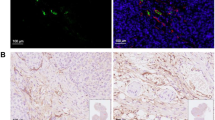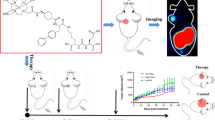Abstract
Purpose
Evans blue as an albumin binder has been widely used to improve pharmacokinetics and enhance tumor uptake of radioligands, including prostate-specific membrane antigen (PSMA) targeting agents. The goal of this study is to develop an optimal Evans blue-modified radiotherapeutic agent that could maximize the absolute tumor uptake and tumor absorbed dose thus the therapeutic efficacy to allow treatment of tumors even with moderate level of PSMA expression.
Methods
[177Lu]Lu-LNC1003 was synthesized based on PSMA-targeting agent and Evans blue. Binding affinity and PSMA targeting specificity were verified through cell uptake and competition binding assay in 22Rv1 tumor model that has moderate level of PSMA expression. SPECT/CT imaging and biodistribution studies in 22Rv1 tumor-bearing mice were performed to evaluate the preclinical pharmacokinetics. Radioligand therapy studies were conducted to systematically assess the therapeutic effect of [177Lu]Lu-LNC1003.
Results
LNC1003 showed high binding affinity (IC50 = 10.77 nM) to PSMA in vitro, which was comparable with that of PSMA-617 (IC50 = 27.49 nM) and EB-PSMA-617 (IC50 = 7.91 nM). SPECT imaging of [177Lu]Lu-LNC1003 demonstrated significantly improved tumor uptake and retention as compared with [177Lu]Lu-EB-PSMA and [177Lu]Lu-PSMA-617, making it suitable for prostate cancer therapy. Biodistribution studies further confirmed the remarkably higher tumor uptake of [177Lu]Lu-LNC1003 (138.87 ± 26.53%ID/g) over [177Lu]Lu-EB-PSMA-617 (29.89 ± 8.86%ID/g) and [177Lu]Lu-PSMA-617 (4.28 ± 0.25%ID/g) at 24 h post-injection. Targeted radioligand therapy results showed noteworthy inhibition of 22Rv1 tumor growth after administration of a single dose of 18.5 MBq [177Lu]Lu-LNC1003. There was no obvious antitumor effect after [177Lu]Lu-PSMA-617 treatment under the same condition.
Conclusion
In this study, [177Lu]Lu-LNC1003 was successfully synthesized with high radiochemical purity and stability. High binding affinity and PSMA targeting specificity were identified in vitro and in vivo. With greatly enhanced tumor uptake and retention, [177Lu]Lu-LNC1003 has the potential to improve therapeutic efficacy using significantly lower dosages and less cycles of 177Lu that promises clinical translation to treat prostate cancer with various levels of PSMA expression.








Similar content being viewed by others
Data Availability
The datasets generated and analyzed during the current research are available from the corresponding author on reasonable request.
References
Virgolini I, Decristoforo C, Haug A, Fanti S, Uprimny C. Current status of theranostics in prostate cancer. Eur J Nucl Med Mol Imaging. 2018;45:471–95.
Cytawa W, Kircher S, Kübler H, Werner RA, Weber S, Hartrampf P, et al. Diverse PSMA expression in primary prostate cancer: reason for negative [68Ga]Ga-PSMA PET/CT scans? Immunohistochemical validation in 40 surgical specimens. Eur J Nucl Med Mol Imaging. 2022;49:3938–49.
Sun M, Niaz MJ, Niaz MO, Tagawa ST. Prostate-specific membrane antigen (PSMA)-targeted radionuclide therapies for prostate cancer. Curr Oncol Rep. 2021;23:59.
Peters SMB, Hofferber R, Privé BM, de Bakker M, Gotthardt M, Janssen M, et al. [68Ga]Ga-PSMA-11 PET imaging as a predictor for absorbed doses in organs at risk and small lesions in [177Lu]Lu-PSMA-617 treatment. Eur J Nucl Med Mol Imaging. 2022;49:1101–12.
Maffey-Steffan J, Scarpa L, Svirydenka A, Nilica B, Mair C, Buxbaum S, et al. The 68Ga/177Lu-theragnostic concept in PSMA-targeting of metastatic castration-resistant prostate cancer: impact of post-therapeutic whole-body scintigraphy in the follow-up. Eur J Nucl Med Mol Imaging. 2020;47:695–712.
Schmidkonz C, Götz TI, Atzinger A, Ritt P, Prante O, Kuwert T, et al. 99mTc-MIP-1404 SPECT/CT for assessment of whole-body tumor burden and treatment response in patients with biochemical recurrence of prostate cancer. Clin Nucl Med. 2020;45:e349–57.
Cytawa W, Seitz AK, Kircher S, Fukushima K, Tran-Gia J, Schirbel A, et al. 68Ga-PSMA I&T PET/CT for primary staging of prostate cancer. Eur J Nucl Med Mol Imaging. 2020;47:168–77.
Voter AF, Werner RA, Pienta KJ, Gorin MA, Pomper MG, Solnes LB, et al. Piflufolastat F-18 (18F-DCFPyL) for PSMA PET imaging in prostate cancer. Expert Rev Anticancer Ther. 2022;22:681–94.
Hennrich U, Eder M. [68Ga]Ga-PSMA-11: The First FDA-Approved 68Ga-radiopharmaceutical for pet imaging of prostate cancer. Pharmaceuticals (Basel). 2021;14:713.
Morris MJ, Rowe SP, Gorin MA, Saperstein L, Pouliot F, Josephson D, et al. Diagnostic performance of 18F-DCFPyL-PET/CT in men with biochemically recurrent prostate cancer: results from the CONDOR phase III, multicenter study. Clin Cancer Res. 2021;27:3674–82.
FDA approves 18F-DCFPyL PET agent in prostate cancer. J Nucl Med. 2021;62:11N–22N.
FDA approves pluvicto/locametz for metastatic castration-resistant prostate cancer. J Nucl Med. 2022;63:13N.
Afshar-Oromieh A, Haberkorn U, Zechmann C, Armor T, Mier W, Spohn F, et al. Repeated PSMA-targeting radioligand therapy of metastatic prostate cancer with 131I-MIP-1095. Eur J Nucl Med Mol Imaging. 2017;44:950–9.
Benesova M, Schafer M, Bauder-Wust U, Afshar-Oromieh A, Kratochwil C, Mier W, et al. Preclinical Evaluation of a tailor-made DOTA-Conjugated PSMA inhibitor with optimized linker moiety for imaging and endoradiotherapy of prostate cancer. J Nucl Med. 2015;56:914–20.
Kratochwil C, Giesel FL, Stefanova M, Benesova M, Bronzel M, Afshar-Oromieh A, et al. PSMA-targeted radionuclide therapy of metastatic castration-resistant prostate cancer with 177Lu-labeled PSMA-617. J Nucl Med. 2016;57:1170–6.
Violet J, Jackson P, Ferdinandus J, Sandhu S, Akhurst T, Iravani A, et al. Dosimetry of 177Lu-PSMA-617 in metastatic castration-resistant prostate cancer: correlations between pretherapeutic imaging and whole-body tumor dosimetry with treatment outcomes. J Nucl Med. 2019;60:517–23.
Hennrich U, Eder M. [177Lu]Lu-PSMA-617 (Pluvicto(TM)): the first FDA-approved radiotherapeutical for treatment of prostate cancer. Pharmaceuticals (Basel). 2022;15:1292.
Wen X, Xu P, Shi M, Liu J, Zeng X, Zhang Y, et al. Evans blue-modified radiolabeled fibroblast activation protein inhibitor as long-acting cancer therapeutics. Theranostics. 2022;12:422–33.
Wen X, Shi C, Yang L, Zeng X, Lin X, Huang J, et al. A radioiodinated FR-β-targeted tracer with improved pharmacokinetics through modification with an albumin binder for imaging of macrophages in AS and NAFL. Eur J Nucl Med Mol Imaging. 2022;49:503–16.
Deberle LM, Tschan VJ, Borgna F, Sozzi-Guo F, Bernhardt P, Schibli R, et al. Albumin-binding PSMA radioligands: impact of minimal structural changes on the tissue distribution profile. Molecules. 2020;25:2542.
Deberle LM, Benesova M, Umbricht CA, Borgna F, Buchler M, Zhernosekov K, et al. Development of a new class of PSMA radioligands comprising ibuprofen as an albumin-binding entity. Theranostics. 2020;10:1678–93.
Umbricht CA, Benesova M, Schibli R, Muller C. Preclinical development of novel psma-targeting radioligands: modulation of albumin-binding properties to improve prostate cancer therapy. Mol Pharm. 2018;15:2297–306.
Kramer V, Fernandez R, Lehnert W, Jimenez-Franco LD, Soza-Ried C, Eppard E, et al. Biodistribution and dosimetry of a single dose of albumin-binding ligand [177Lu]Lu-PSMA-ALB-56 in patients with mCRPC. Eur J Nucl Med Mol Imaging. 2021;48:893–903.
Kuo HT, Merkens H, Zhang Z, Uribe CF, Lau J, Zhang C, et al. Enhancing Treatment efficacy of 177Lu-PSMA-617 with the conjugation of an albumin-binding motif: preclinical dosimetry and endoradiotherapy studies. Mol Pharm. 2018;15:5183–91.
Ben Jemaa A, Sallami S, Céraline J, Oueslati R. A novel regulation of PSMA and PSA expression by Q640X AR in 22Rv1 and LNCaP prostate cancer cells. Cell Biol Int. 2013;37:464–70.
Tsourlakis MC, Klein F, Kluth M, Quaas A, Graefen M, Haese A, et al. PSMA expression is highly homogenous in primary prostate cancer. Appl Immunohistochem Mol Morphol. 2015;23:449–55.
Seifert R, Seitzer K, Herrmann K, Kessel K, Schäfers M, Kleesiek J, et al. Analysis of PSMA expression and outcome in patients with advanced prostate cancer receiving 177Lu-PSMA-617 radioligand therapy. Theranostics. 2020;10:7812–20.
Wang Z, Tian R, Niu G, Ma Y, Lang L, Szajek LP, et al. Single low-dose injection of evans blue modified PSMA-617 radioligand therapy eliminates prostate-specific membrane antigen positive tumors. Bioconjug Chem. 2018;29:3213–21.
Walsh SJ, Bargh JD, Dannheim FM, Hanby AR, Seki H, Counsell AJ, et al. Site-selective modification strategies in antibody-drug conjugates. Chem Soc Rev. 2021;50:1305–53.
Huang W, Wu X, Gao X, Yu Y, Lei H, Zhu Z, et al. Maleimide-thiol adducts stabilized through stretching. Nat Chem. 2019;11:310–9.
Lyon RP, Setter JR, Bovee TD, Doronina SO, Hunter JH, Anderson ME, et al. Self-hydrolyzing maleimides improve the stability and pharmacological properties of antibody-drug conjugates. Nat Biotechnol. 2014;32:1059–62.
Zang J, Liu Q, Sui H, Wang R, Jacobson O, Fan X, et al. 177Lu-EB-PSMA radioligand therapy with escalating doses in patients with metastatic castration-resistant prostate cancer. J Nucl Med. 2020;61:1772–8.
Wang G, Zang J, Jiang Y, Liu Q, Sui H, Wang R, et al. A single-arm, low-dose, prospective study of 177Lu-EB-PSMA radioligand therapy in patients with metastatic castration-resistant prostate cancer. J Nucl Med. 2023;64:611–617.
Lin D, De Kouchkovsky I, Aggarwal R, Hope T. The increased prevalence of low and heterogeneous PSMA uptake in the setting of metastatic castration-resistant prostate cancer. J Nucl Med. 2021;62:1349.
Mannweiler S, Amersdorfer P, Trajanoski S, Terrett JA, King D, Mehes G. Heterogeneity of prostate-specific membrane antigen (PSMA) expression in prostate carcinoma with distant metastasis. Pathol Oncol Res. 2009;15:167–72.
Yordanova A, Becker A, Eppard E, Kürpig S, Fisang C, Feldmann G, et al. The impact of repeated cycles of radioligand therapy using [177Lu]Lu-PSMA-617 on renal function in patients with hormone refractory metastatic prostate cancer. Eur J Nucl Med Mol Imaging. 2017;44:1473–9.
Khreish F, Ghazal Z, Marlowe RJ, Rosar F, Sabet A, Maus S, et al. 177Lu-PSMA-617 radioligand therapy of metastatic castration-resistant prostate cancer: Initial 254-patient results from a prospective registry (REALITY Study). Eur J Nucl Med Mol Imaging. 2022;49:1075–85.
Lütje S, Heskamp S, Cornelissen AS, Poeppel TD, van den Broek SA, Rosenbaum-Krumme S, et al. PSMA ligands for radionuclide imaging and therapy of prostate cancer: clinical status. Theranostics. 2015;5:1388–401.
Rousseau E, Lau J, Kuo HT, Zhang Z, Merkens H, Hundal-Jabal N, et al. Monosodium glutamate reduces 68Ga-PSMA-11 uptake in salivary glands and kidneys in a preclinical prostate cancer model. J Nucl Med. 2018;59:1865–8.
Michelet F, Gueguen R, Leroy P, Wellman M, Nicolas A, Siest G. Blood and plasma glutathione measured in healthy subjects by HPLC: relation to sex, aging, biological variables, and life habits. Clin Chem. 1995;41:1509–17.
Jones DP, Carlson JL, Samiec PS, Sternberg P Jr, Mody VC Jr, Reed RL, et al. Glutathione measurement in human plasma. Evaluation of sample collection, storage and derivatization conditions for analysis of dansyl derivatives by HPLC. Clin Chim Acta. 1998;275:175–84.
Estrela JM, Ortega A, Obrador E. Glutathione in cancer biology and therapy. Crit Rev Clin Lab Sci. 2006;43:143–81.
Funding
This study was founded by the National Natural Science Foundation of China (81901805, 21976150), Major Research Plan of the National Natural Science Foundation of China (91959122), Joint Fund of the National Natural Science Foundation of China—China National Nuclear Corporation for Nuclear Technology Innovation (U1967222), Fundamental Research Funds for the Central Universities of China (20720210115), the National University of Singapore Start-up Grant (NUHSRO/2020/133/Startup/08; NUHSRO/2021/097/Startup/13), NUS School of Medicine Nanomedicine Translational Research Programme (NUHSRO/2021/034/TRP/09/Nanomedicine).
Author information
Authors and Affiliations
Corresponding authors
Ethics declarations
Ethical approval
Animal experiments were approved by the animal care committee of Xiamen University (ID XMULAC20190157) and carried out in compliance with the national laws related to the conduct of animal experimentation. This article does not contain any studies with human participants performed by any of the authors.
Conflict of interest
The authors declare no competing interests.
Additional information
Publisher's note
Springer Nature remains neutral with regard to jurisdictional claims in published maps and institutional affiliations.
This article is part of the Topical Collection on Theragnostic
Supplementary Information
Below is the link to the electronic supplementary material.
Rights and permissions
Springer Nature or its licensor (e.g. a society or other partner) holds exclusive rights to this article under a publishing agreement with the author(s) or other rightsholder(s); author self-archiving of the accepted manuscript version of this article is solely governed by the terms of such publishing agreement and applicable law.
About this article
Cite this article
Wen, X., Xu, P., Zeng, X. et al. Development of [177Lu]Lu-LNC1003 for radioligand therapy of prostate cancer with a moderate level of PSMA expression. Eur J Nucl Med Mol Imaging 50, 2846–2860 (2023). https://doi.org/10.1007/s00259-023-06229-w
Received:
Accepted:
Published:
Issue Date:
DOI: https://doi.org/10.1007/s00259-023-06229-w




